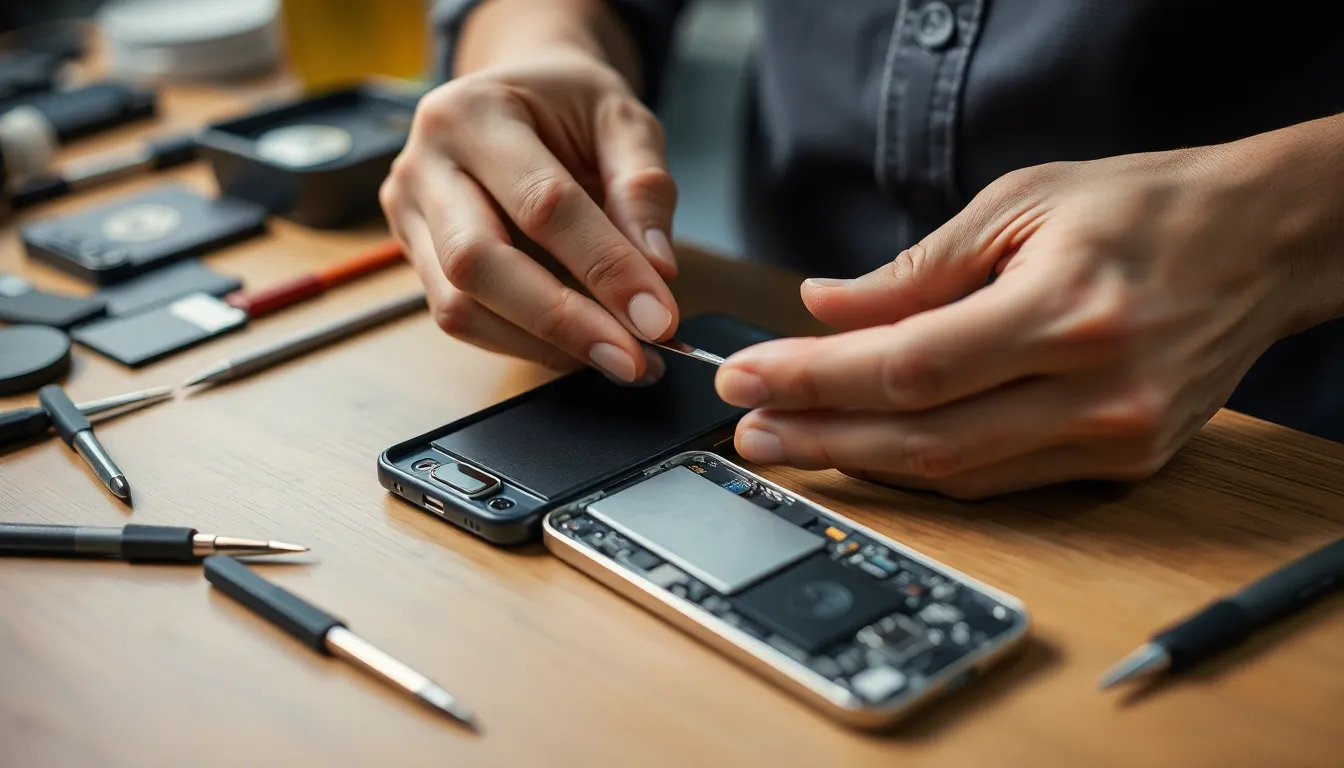In today’s fast-paced world, a smartphone’s battery life can make or break the user experience. As devices age, battery performance typically declines, leading to unexpected shutdowns and frustrating charging cycles. Understanding when and how to replace a smartphone battery is essential for maintaining functionality and prolonging the device’s lifespan.
Many people overlook the signs that their battery needs replacing, often waiting until it’s too late. Knowing the symptoms of battery degradation can help users take proactive steps. Whether it’s a sudden drop in battery percentage or overheating during use, recognizing these issues can save time and money. This article explores the ins and outs of smartphone battery replacement, offering insights into when it’s necessary and how to approach the process effectively.
Table of Contents
ToggleOverview of Smartphone Battery Replacement
Smartphone battery replacement addresses declining battery performance, ensuring devices function efficiently. Users noticing signs of degradation, such as inconsistent battery percentage or overheating, should consider replacement to maintain optimal functionality.
Replacement options include professional services or DIY methods. Professional services offer expertise and typically include warranties, which enhance reliability. Users opting for DIY replacements often find kits available that include necessary tools and instructions.
When replacing batteries, it’s crucial to choose high-quality, compatible batteries to avoid damage and ensure longevity. Various resources provide guidance on battery specifications for different smartphone models, aiding in selection.
Users can improve battery life by adopting best practices, such as avoiding extreme temperatures and optimizing app usage. Understanding proper charging habits and battery maintenance can prolong battery lifespan, reducing the need for frequent replacements.
Why Replace Your Smartphone Battery?

Replacing your smartphone battery enhances performance, prolongs device life, and improves user satisfaction. Recognizing signs of battery failure at the right time ensures effective replacement and optimal functionality.
Signs of a Failing Battery
- Sudden Percentage Drops: Users observe unexpected battery percentage drops, indicating reduced capacity.
- Overheating: Devices feel unusually hot during use or charging, suggesting potential battery issues.
- Frequent Shutdowns: Smartphones shut down unexpectedly, even with a remaining charge, highlighting battery malfunction.
- Increased Charging Time: Batteries take longer to reach a full charge, signaling degraded efficiency.
- Swelling or Physical Damage: Users notice physical changes, such as battery swelling, which poses safety risks.
Benefits of Battery Replacement
- Enhanced Performance: Replacing an aging battery restores optimal performance and responsiveness to apps and features.
- Extended Device Lifespan: A new battery minimizes wear on device components, prolonging overall lifespan.
- Improved Reliability: New batteries provide dependable and consistent power, reducing unexpected shutdowns and interruptions.
- Cost-Effective Solution: Investing in a battery replacement is often more economical than purchasing a new smartphone.
- Sustainable Practice: Maintaining and replacing parts of existing devices contributes to reduced electronic waste.
How to Replace Your Smartphone Battery
Replacing a smartphone battery effectively enhances device longevity and performance. Users can opt for DIY methods or professional services based on their preferences and technical skill levels.
DIY Replacement Steps
- Gather necessary tools: Users require a screwdriver, a plastic opening tool, and possibly tweezers to facilitate the replacement process.
- Power off the device: Turning off the smartphone minimizes risks associated with electrical hazards.
- Remove the back cover: Carefully use an opening tool to detach the back cover without damaging clips or components.
- Disconnect the battery: Locate the battery connector and gently lift it from the motherboard, ensuring no damage occurs.
- Replace the battery: Remove the old battery and insert the new one, ensuring it fits correctly and aligns with connectors.
- Reconnect the battery: Firmly attach the battery connector to the motherboard.
- Reassemble the device: Snap the back cover into place and ensure it’s securely fastened.
- Power on the device: Turn the smartphone back on to confirm proper battery installation and functionality.
Professional Replacement Services
- Expertise available: Professionals possess technical skills to handle various smartphone models, ensuring proper battery replacement.
- Warranty options: Services often include warranties, providing users with reassurance and protection against defects or installation errors.
- Quality assurance: Professionals use high-quality, compatible batteries that meet manufacturer specifications, minimizing risks of damage.
- Time-saving: Entrusting the replacement to experts saves time, as they complete the task efficiently and promptly.
- Comprehensive service: Many facilities offer additional diagnostics and repairs, potentially addressing underlying issues that may affect battery performance.
Choosing the Right Battery
Selecting the appropriate battery significantly impacts smartphone performance and longevity. Users must consider multiple factors to ensure an efficient replacement.
Original vs. Third-Party Batteries
Original batteries come directly from the smartphone manufacturer and guarantee compatibility and reliability. Using original batteries minimizes the risk of device malfunctions and maintains manufacturer warranties. In contrast, third-party batteries can offer cost savings and varying performance levels. While some third-party batteries perform well, others may lack quality assurance or compatibility. Researching reputable brands and reading customer reviews ensures better outcomes when opting for third-party options.
Battery Capacity and Compatibility
Battery capacity, measured in milliampere-hours (mAh), determines how long a battery lasts between charges. Higher capacity batteries provide longer usage times but must match the smartphone’s specifications. Compatibility is crucial; using a battery designed for a different model could lead to performance issues or damage. Always check the specifications from the manufacturer or trusted sources to ensure the replacement battery meets the device’s required standards. Proper capacity and compatibility lead to optimal performance and enhanced battery life.
Cost Considerations
Understanding the costs involved in smartphone battery replacement is crucial for making informed decisions. Both the direct and potential hidden costs can significantly impact the overall expense of the replacement process.
Average Costs for Battery Replacement
Average costs for battery replacement vary based on several factors. Professional services generally range from $50 to $125, depending on the smartphone model and service provider. DIY battery replacement, including a quality battery kit, typically costs between $20 and $60. Original manufacturer batteries may fall at the higher end of this spectrum, while third-party options provide cheaper alternatives.
| Replacement Type | Estimated Cost Range |
|---|---|
| Professional Service | $50 – $125 |
| DIY Kit (Third-Party) | $20 – $60 |
| Original Battery | $30 – $70 |
Hidden Costs to Consider
Hidden costs may arise during or after the battery replacement process. Users may encounter additional expenses for tools if they pursue a DIY method and do not already own necessary equipment. Furthermore, poor-quality batteries can lead to malfunctions, prompting costs for further repairs. Warranty limitations on third-party batteries can also increase long-term expenses if the device suffers damage. Lastly, if professional services reveal underlying issues, such as damaged connectors or screens, repair costs may add to the total overall expenditure.










